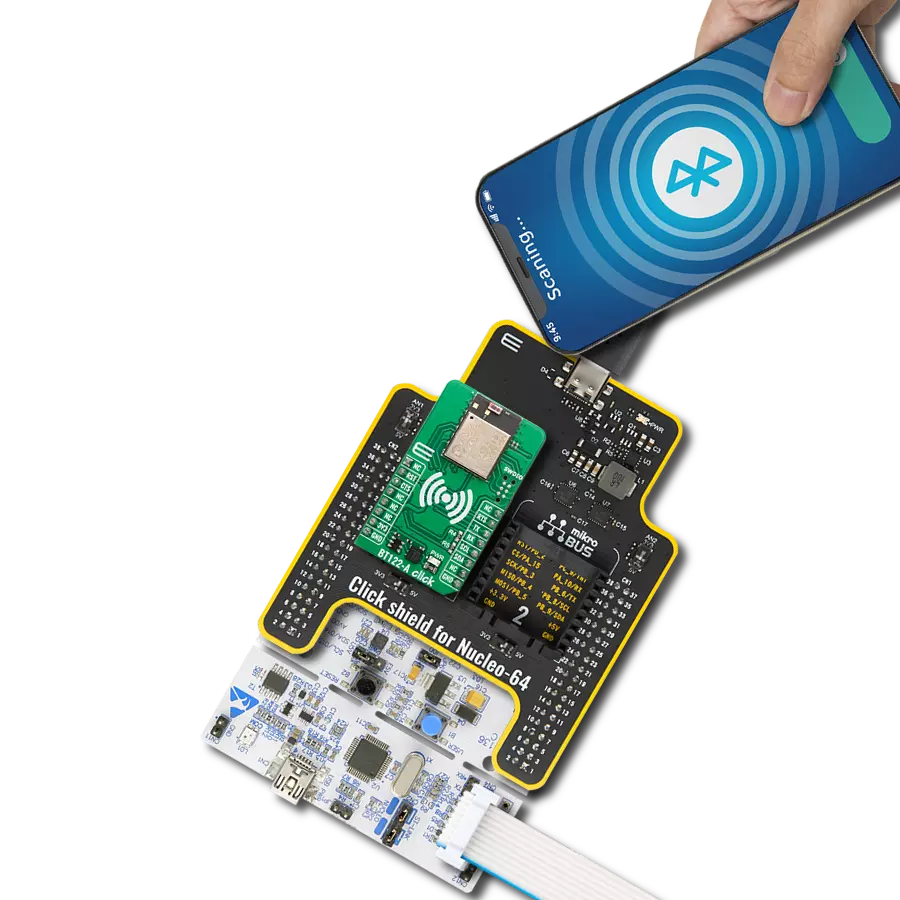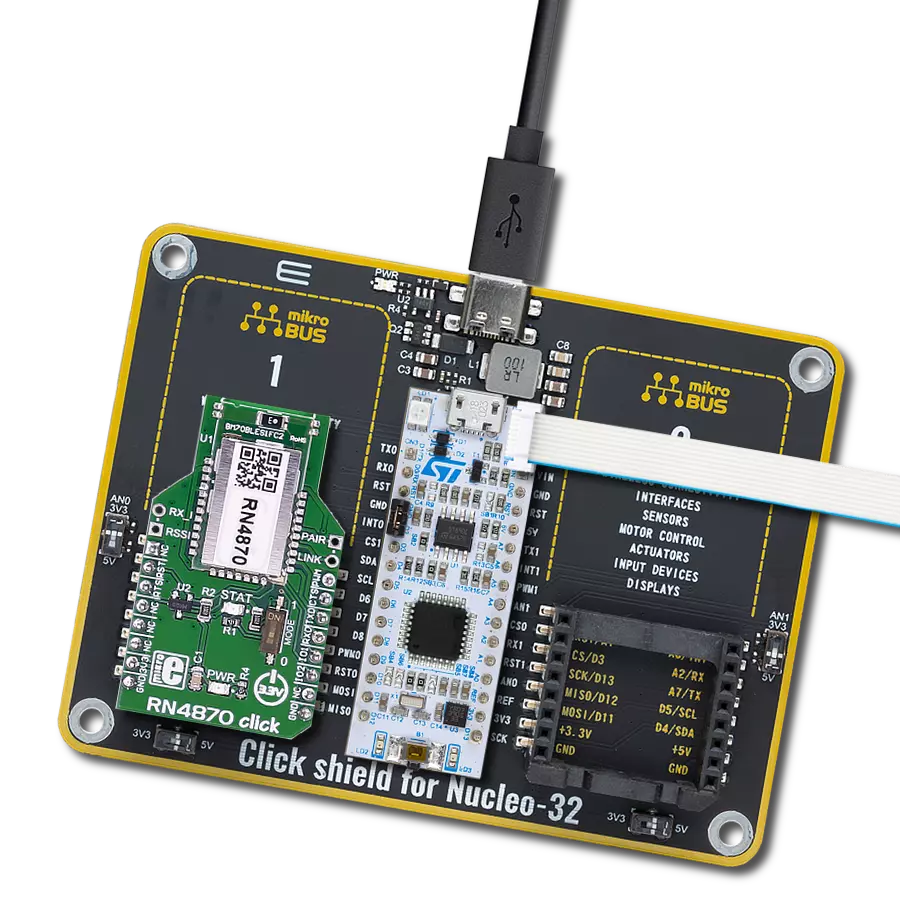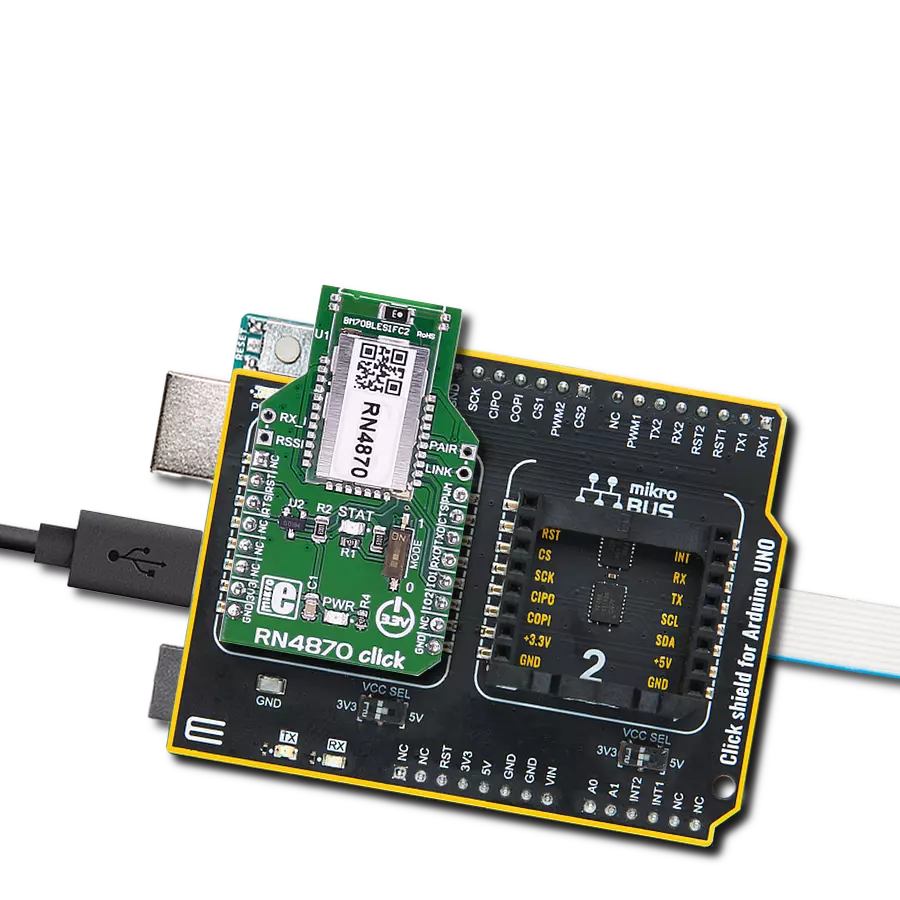Our Bluetooth solution empowers you to enjoy wireless audio, transfer files, and interact with smart devices, all while experiencing unmatched reliability and efficiency
A
A
Hardware Overview
How does it work?
BLE 8 Click is based on the ANNA-B112, a standalone Bluetooth 5 low-energy module from u-blox based on the nRF52832 chip. The nRF52832 is the mid-range member of the nRF52 Series SoC family. It meets the challenges of a broad range of applications requiring Bluetooth 5 feature sets, protocol concurrency, and a rich and varied set of peripherals and features. In addition, it offers generous memory availability for both Flash and RAM. It is operated by a set of AT commands over the UART interface, which makes the BLE 8 click very easy to use. By integrating most of the critical components on the chip, the ANNA-B112 allows the module to overcome any imperfections of external discrete components, allowing signal transmission power of up to 5dBm, and -92 dBm
sensitivity for the receiver, using the on-chip antenna. The ANNA-B112 module is built around an ARM® Cortex™-M4 CPU with a floating point unit running at 64 MHz. It has NFC-A Tag for use in simplified pairing and payment solutions and numerous digital peripherals and interfaces, such as PDM and I2S, for digital microphones and audio. It is also fully multiprotocol capable with full protocol concurrency. It has protocol support for Bluetooth 5, Bluetooth mesh, ANT, and 2.4 GHz proprietary stacks. Besides the mikroBUS™ socket, BLE 8 click also features two optional 6-pin header mounts with marked pin labels. All of these pins can be externally connected and used for various purposes. SWDCLK and SWDIO pins are reserved for the SWD interface, which the ANNA-B112 series
modules use for flashing and debugging. The rest of the external pins, labeled as IO1-IO10, are general purpose IO type and can be programmed according to the users' needs. The onboard buttons T1 and T2 and the RGB, LED LD2 (labeled SYS) are also user programmable and can be used for various purposes for basic user interaction without any external components required besides the BLE 8 click. This Click board™ can be operated only with a 3.3V logic voltage level. The board must perform appropriate logic voltage level conversion before using MCUs with different logic levels. Also, it comes equipped with a library containing functions and an example code that can be used, as a reference, for further development.
Features overview
Development board
Nucleo-64 with STM32F091RC MCU offers a cost-effective and adaptable platform for developers to explore new ideas and prototype their designs. This board harnesses the versatility of the STM32 microcontroller, enabling users to select the optimal balance of performance and power consumption for their projects. It accommodates the STM32 microcontroller in the LQFP64 package and includes essential components such as a user LED, which doubles as an ARDUINO® signal, alongside user and reset push-buttons, and a 32.768kHz crystal oscillator for precise timing operations. Designed with expansion and flexibility in mind, the Nucleo-64 board features an ARDUINO® Uno V3 expansion connector and ST morpho extension pin
headers, granting complete access to the STM32's I/Os for comprehensive project integration. Power supply options are adaptable, supporting ST-LINK USB VBUS or external power sources, ensuring adaptability in various development environments. The board also has an on-board ST-LINK debugger/programmer with USB re-enumeration capability, simplifying the programming and debugging process. Moreover, the board is designed to simplify advanced development with its external SMPS for efficient Vcore logic supply, support for USB Device full speed or USB SNK/UFP full speed, and built-in cryptographic features, enhancing both the power efficiency and security of projects. Additional connectivity is
provided through dedicated connectors for external SMPS experimentation, a USB connector for the ST-LINK, and a MIPI® debug connector, expanding the possibilities for hardware interfacing and experimentation. Developers will find extensive support through comprehensive free software libraries and examples, courtesy of the STM32Cube MCU Package. This, combined with compatibility with a wide array of Integrated Development Environments (IDEs), including IAR Embedded Workbench®, MDK-ARM, and STM32CubeIDE, ensures a smooth and efficient development experience, allowing users to fully leverage the capabilities of the Nucleo-64 board in their projects.
Microcontroller Overview
MCU Card / MCU

Architecture
ARM Cortex-M0
MCU Memory (KB)
256
Silicon Vendor
STMicroelectronics
Pin count
64
RAM (Bytes)
32768
You complete me!
Accessories
Click Shield for Nucleo-64 comes equipped with two proprietary mikroBUS™ sockets, allowing all the Click board™ devices to be interfaced with the STM32 Nucleo-64 board with no effort. This way, Mikroe allows its users to add any functionality from our ever-growing range of Click boards™, such as WiFi, GSM, GPS, Bluetooth, ZigBee, environmental sensors, LEDs, speech recognition, motor control, movement sensors, and many more. More than 1537 Click boards™, which can be stacked and integrated, are at your disposal. The STM32 Nucleo-64 boards are based on the microcontrollers in 64-pin packages, a 32-bit MCU with an ARM Cortex M4 processor operating at 84MHz, 512Kb Flash, and 96KB SRAM, divided into two regions where the top section represents the ST-Link/V2 debugger and programmer while the bottom section of the board is an actual development board. These boards are controlled and powered conveniently through a USB connection to program and efficiently debug the Nucleo-64 board out of the box, with an additional USB cable connected to the USB mini port on the board. Most of the STM32 microcontroller pins are brought to the IO pins on the left and right edge of the board, which are then connected to two existing mikroBUS™ sockets. This Click Shield also has several switches that perform functions such as selecting the logic levels of analog signals on mikroBUS™ sockets and selecting logic voltage levels of the mikroBUS™ sockets themselves. Besides, the user is offered the possibility of using any Click board™ with the help of existing bidirectional level-shifting voltage translators, regardless of whether the Click board™ operates at a 3.3V or 5V logic voltage level. Once you connect the STM32 Nucleo-64 board with our Click Shield for Nucleo-64, you can access hundreds of Click boards™, working with 3.3V or 5V logic voltage levels.
Used MCU Pins
mikroBUS™ mapper
Take a closer look
Click board™ Schematic

Step by step
Project assembly
Software Support
Library Description
This library contains API for BLE 8 Click driver.
Key functions:
ble8_reset- This function allows user to reset a module
Open Source
Code example
The complete application code and a ready-to-use project are available through the NECTO Studio Package Manager for direct installation in the NECTO Studio. The application code can also be found on the MIKROE GitHub account.
/*!
* \file
* \brief Ble8 Click example
*
* # Description
* This example reads and processes data from BLE 8 Clicks.
*
* The demo application is composed of two sections :
*
* ## Application Init
* Initializes driver and wake-up module.
*
* ## Application Task
* Reads the received data.
*
* ## Additional Function
* - ble8_process ( ) - Logs all received messages on UART, and sends the certain message back to the connected device.
*
* *note:*
* <pre>
* The all possible commands, module configuration and specification can be found in the
* related documents:
* [1] ANNA-B112 System Integration Manual, document number UBX-18009821
* [2] u-blox Short Range AT Commands Manual, document number UBX-14044127
* [3] ANNA-B112 Getting Started Guide, document number UBX-18020387
* [4] ANNA-B112 Declaration of Conformity, document number UBX-18058993
* </pre>
*
* \author MikroE Team
*
*/
// ------------------------------------------------------------------- INCLUDES
#include "board.h"
#include "log.h"
#include "ble8.h"
#include "string.h"
#define PROCESS_COUNTER 5
#define PROCESS_RX_BUFFER_SIZE 100
#define PROCESS_PARSER_BUFFER_SIZE 100
// ------------------------------------------------------------------ VARIABLES
static ble8_t ble8;
static log_t logger;
static uint8_t data_mode = 0;
static char current_parser_buf[ PROCESS_PARSER_BUFFER_SIZE ];
// ------------------------------------------------------- ADDITIONAL FUNCTIONS
static int8_t ble8_process ( void )
{
int32_t rsp_size;
uint16_t rsp_cnt = 0;
char uart_rx_buffer[ PROCESS_RX_BUFFER_SIZE ] = { 0 };
uint8_t check_buf_cnt;
uint8_t process_cnt = PROCESS_COUNTER;
// Clear current buffer
memset( current_parser_buf, 0, PROCESS_PARSER_BUFFER_SIZE );
while( process_cnt != 0 )
{
rsp_size = ble8_generic_read( &ble8, uart_rx_buffer, PROCESS_RX_BUFFER_SIZE );
if ( rsp_size > 0 )
{
// Validation of the received data
for ( check_buf_cnt = 0; check_buf_cnt < rsp_size; check_buf_cnt++ )
{
if ( uart_rx_buffer[ check_buf_cnt ] == 0 )
{
uart_rx_buffer[ check_buf_cnt ] = 13;
}
}
// Storages data in current buffer
rsp_cnt += rsp_size;
if ( rsp_cnt < PROCESS_PARSER_BUFFER_SIZE )
{
strncat( current_parser_buf, uart_rx_buffer, rsp_size );
}
// Clear RX buffer
memset( uart_rx_buffer, 0, PROCESS_RX_BUFFER_SIZE );
if (strstr(current_parser_buf, "ERROR")) {
return -1;
}
if (strstr(current_parser_buf, "OK")) {
log_printf( &logger, "%s", current_parser_buf );
Delay_100ms( );
return 1;
}
if ( data_mode == 1) {
log_printf( &logger, "%s", current_parser_buf );
uart_write( &ble8.uart, "Hello", 5 );
Delay_ms ( 1000 );
Delay_ms ( 1000 );
uart_write( &ble8.uart, "BLE8", 4 );
}
}
else
{
process_cnt--;
// Process delay
Delay_ms ( 100 );
}
}
return 0;
}
// ------------------------------------------------------ APPLICATION FUNCTIONS
void application_init ( void )
{
log_cfg_t log_cfg;
ble8_cfg_t cfg;
/**
* Logger initialization.
* Default baud rate: 115200
* Default log level: LOG_LEVEL_DEBUG
* @note If USB_UART_RX and USB_UART_TX
* are defined as HAL_PIN_NC, you will
* need to define them manually for log to work.
* See @b LOG_MAP_USB_UART macro definition for detailed explanation.
*/
LOG_MAP_USB_UART( log_cfg );
log_init( &logger, &log_cfg );
log_info( &logger, "---- Application Init ----" );
// Click initialization.
ble8_cfg_setup( &cfg );
BLE8_MAP_MIKROBUS( cfg, MIKROBUS_1 );
ble8_init( &ble8, &cfg );
ble8_reset( &ble8 );
Delay_1sec( );
log_printf( &logger, "Configuring the module...\n" );
Delay_1sec( );
ble8_set_dsr_pin( &ble8, 1 );
Delay_ms ( 20 );
do {
ble8_set_echo_cmd( &ble8, 1 );
Delay_100ms( );
}
while( ble8_process( ) != 1 );
do {
ble8_set_local_name_cmd( &ble8, "BLE 8 Click" );
Delay_100ms( );
}
while( ble8_process( ) != 1 );
do {
ble8_connectability_en_cmd( &ble8, BLE8_GAP_CONNECTABLE_MODE );
Delay_100ms( );
}
while( ble8_process( ) != 1 );
do {
ble8_discoverability_en_cmd( &ble8, BLE8_GAP_GENERAL_DISCOVERABLE_MODE );
Delay_100ms( );
}
while( ble8_process( ) != 1 );
do {
ble8_enter_mode_cmd( &ble8, BLE8_DATA_MODE );
Delay_100ms( );
}
while( ble8_process( ) != 1 );
ble8_set_dsr_pin( &ble8, 0 );
Delay_ms ( 20 );
data_mode = 1;
log_printf( &logger, "The module has been configured.\n" );
}
void application_task ( void )
{
ble8_process( );
}
int main ( void )
{
/* Do not remove this line or clock might not be set correctly. */
#ifdef PREINIT_SUPPORTED
preinit();
#endif
application_init( );
for ( ; ; )
{
application_task( );
}
return 0;
}
// ------------------------------------------------------------------------ END
Additional Support
Resources
Category:BT/BLE

































